| INDEX | 1300-1599 | 1600s | 1700s | 1800s | 1900s | CROSS-ERA | ETHNO | |
| MISCELLANY | CONTACT | SEARCH | |
|
|
|
For reasons of decency, we start with a lady who already wears the shift, a cap and stockings. Can't be havin' with pictures of wimmin without a cap on. ;) The over-knee stockings are fastened with garters just below the knee. The stocking page will also explain why it is below the knee, not above. If she hasn't done so yet, she now has to put on the shoes unless she intends to wear mules as she does here, or has a maid who will fasten the shoe buckles. As soon as she has the stays on, she will hardly be able to bend down to fasten them herself. |
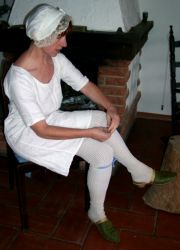 |
|
Now she ties on the decency skirt. In the pictures, we have left it out for simplicity. Next, the stays are put on. Remember to use spiral lacing! Before tightening the lace, pull the shift straight so that its neckline sits just right. See to it that the shift fabric is distributed evenly all around. Find more information about putting on stays here. |
 |
|
The pocket hoops are tied on. This is a small variant of the hoop skirt that was worn after c. 1750 and doubled as pockets. If a proper panier is worn, you first tie on a pair of pockets and then the panier on top of it. Pockets, paniers and pocket hoops all have narrow waistbands that are long enough to tie in a bow. To make sure that the hoops do not show through the skirt, one or more petticoats should be put on top. They don't have to be very thick, quite contrary: They should be light, except maybe in winter. A large number of folds and stiff of the fabric hides the hoops best. Therefore, the under-petticoats should have as much fabric as the visible petticoat. Two petticoats of thin fabric work better than one petticoat of thick fabric. |
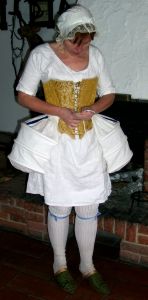 |
|
Now the visible petticoat, the jupe, is put on. The waistband is in two parts (same for the under-petticoats, BTW) and long enough that each half goes all around the body to be tied in a bow. The back half is tied on first... |
 |
|
... and then the front half. This allows the back and front half of the skirt to overlap each other, allowing for changes in a person's girth or for use by more than one person. Since the front half lies on top of the back, the pocket slits are easily accessible from behind even if there is a considerable overlap. |
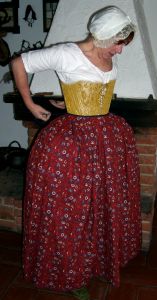 |
|
The stomacher is fastened to the front of the stays. It is pinned on through the flaps on the side of the stomacher. I am often asked whether that wasn't dangerous. Well, when putting the needles in you do have to be careful not to go to deep lest you either hit the boning and break it off, or not hit the boning but the flesh. The pins should be put in vertically, shallowly, and the tips go back into the fabric. If the stays are stiff enough, this will almost happyn automatically. as the robe will be on top, the pins are well hidden both from sight and from skin. |
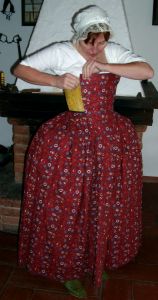 |
|
Now the robe is put on like a coat. The front edges are placed onto the stomacher and pinned to it. The best way to do that is to fold away the robings, place the pins underneath – as close to the front edge as possible – and then fold the robings back to hide them. These needles, too, aren't dangerous if they are put in shallowly from the top down and hidden under the robings. Just to be sure, have the tip go very shallowly back into the fabric. It's more probable that you'll scratch yourself or ruin your engageantes by brushing against a pin tip lying outside the fabric than driving a pin into the skin of your torso. The stays will protect you from the pins. A woman of simple means would wear a jacket rather than a robe in everyday life. The jacket is often a short version of the robe and put on in the same way. |
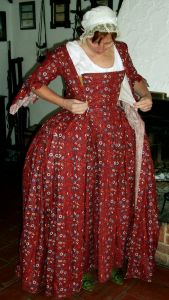 |
|
In case of a robe à la française, a close fit must be provided by pulling tight the strings hidden under the back pleats. Pinning the front edges is easier if these strings are loose. Now is the time to have them re-fastened by a maid. This is another feature that makes the française so well suited for more than one dress size. My model here is at least two sizes away from the person the dress was originally made for. In case of a robe à l'anglaise or à la polonaise, this neither necessary nor possible since both have close-fitting backs anyway. |
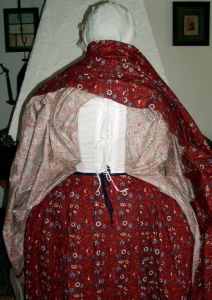 |
|
Add a fichu to cover the neckline, and the lady is fully dressed. For businness outside the home, she may add a mantelet or plisse of black taffeta. But what if it's really cold? I have not found much in the way of winter clothing yet, but i suspect that both mantelets and plisses were not just made of taffeta, but also of wool and possibly fur lining. Commoners may have worn knitted triangular wraps as well. For society occasions, the fichu and cap were left off, an elegant hairdo was made, and of course the lady would put on a silk robe rather than this relatively simple cotton one. |
 |
Content, layout and images of this page
and any sub-page of the domains marquise.de, contouche.de, lumieres.de, manteau.de and costumebase.org are copyright (c) 1997-2022 by Alexa Bender. All rights reserved. See Copyright Page. GDPO
This work is licensed under a Creative Commons License.